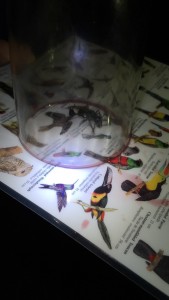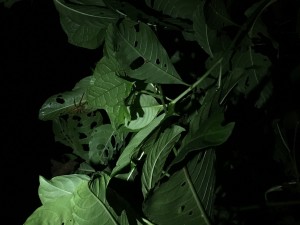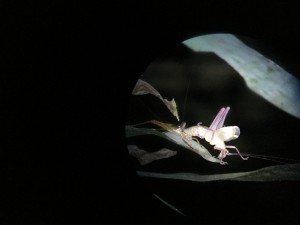This last month has been full of unique experiences in Costa Rica, from working on a coffee farm, to painting my first mural, to becoming the designated savior of my classmates by capturing and releasing the birds, bats, and countless giant insects that routinely found their way inside our bunkhouses. (If this doesn’t sound as fun to you as it was for me, I highly recommend keeping your windows shut during your next visit to the rainforest!) While most travelers to Costa Rica hope to see some feces-slinging capuchins or a kitten-like kinkajou or any number of other cute-and-cuddlies, I’m more of a creepy-crawlies kind of girl when I’m not too focused on what kind of rocks are underneath them. Not only do bugs make for great studying, they make for great eating!
(Except bullet ants. And probably not wolf spiders either.)
My research in Costa Rica focused on leaf cutter ants and their relationship to stream discharge and streamside hill slopes. Unfortunately due to a number of limitations, our results were insignificant, but we were able to raise some interesting questions regarding cost-benefits of colony location. For example, some previous research has shown that leaf cutter ants like to colonize near enough to streams to easily dispose of their colony’s waste (Hoenicke 1983). These ants do not actually eat the leaves they so arduously bring back to their nests, but use them to grow a particular kind of fungus for food (Garrett et al. 2016). These tiny bugs have designed an amazingly effective form of agriculture to feed an entire colony, each one of which can have the same ecological effect on the rainforest as a large herbivore (Herz et al. 2007). However, being such small animals who make their homes underground, flash flooding during the rainy season can be a serious risk to the colony who nests too close to the nearest stream (Sendoya et al. 2014). Colonies who survive inundation may move their nests higher up slopes to prevent reoccurrences. Other benefits of colonizing closer to streams may include increased nutrient content of leaf sources, and this is something we would love to see studied further in the future.
While leaf cutter ants tend to specialize in a few particular types of leaves on which to farm their fungus, I had the opportunity to taste a wide variety of new, delicious dishes in Costa Rica–fresh homemade cheese, heart of palm, blackened tilapia shaped like budding roses. Call me crazy, but my favorite was a snack of termites eaten straight from a rotting log at the foot of the active volcano Mount Arenal. I’m no stranger to anthroentomophagy, or the human consumption of insects. Since trying grasshopper as a child, to always being the first to volunteer as tribute to eat the mezcal worm, to my recent obsession with baking cricket powder into pretty much anything, I’ve been fascinated. After all, class Insecta is practically a sister to Crustacea, a subphylum encompassing my favorite foods of shrimp and crab. But as much as I love my cricket powder, I think termites might be my new favorite creepy-crawly snack. You can eat them raw and live, which makes for a convenient snack, since you don’t have to take the time to cook them like other insects. They have the light popping crunch characteristic of critters with edible exoskeletons, but are too small to noticeably gush goo like a boiled grasshopper when you bite into them and they don’t have huge wings that stick to your teeth popcorn-kernel style like roasted crickets. Best of all, they have a characteristic herbal aftertaste that makes my mouth water as I imagine sprinkling them into some baked potatoes.
(Mmmm, grasshopper.)
You’re probably reading this wondering why I am trying so hard to make insects sound appetizing, but the truth is, not only are they tasty, they’re incredibly healthy and environmentally friendly. Edible insects can contain up to twice as much protein by weight as beef, more calcium than milk, and more iron than spinach. They are also high in fiber, omega-3 fatty acids, and vitamin B12 as well as low-calorie and low-fat (Entomo Farms). Entomophagists need to consume far less biomass in order to gain the same nutritional value as meat eaters, while still conserving calories and fat, and insect farming requires far less land use and produces far less greenhouse gases than livestock farming. With mounting concerns of obesity, malnutrition, and anthropogenic climate change worldwide, insects are a logical solution. Pretty much everywhere we went in Costa Rica, there were cow pastures as far as the eye could see. Ticos eat a lot of meat, as evidenced on a few occasions of miscommunication between our class’s vegetarians and our wonderful kitchen staffs. I’m not suggesting that we replace meat eating with entomophagy entirely, but it cannot and should not be denied that livestock production is a major driver of anthropogenic climate change. Even more sustainable livestock production can create a huge ecological footprint, as Don Roberto reminded us at his shade-grown coffee farm. After visiting some meticulously designed organic farms over the past month, it is an exciting thought to me that perhaps, if adventurous eaters (like my classmates who tried the termites and admitted to enjoying it, or our guide who offered us the incredible edible little guys) continue to spread the word of anthroentomophagy, Costa Ricans may find an ingenious solution to the livestock dilemma.
Entomo Farms. Accessed 2016. Available from entomofarms.com
Garrett RW, Carlson KA, Goggans MS, Nesson MH, Shepherd CA, Schofield RM. 2016. Leaf processing behavior in Atta leaf cutter ants: 90% of leaf cutting takes place inside the nest, and ants select pieces that require less cutting. R Soc Open Sci, 150111. http://dx.doi.org/10.1098/rsos.150111
Herz H, Beyschlag W, Hölldobler B. 2007. Herbivory rate of leaf-cutting ants in a tropical moist forest in Panama at the population and ecosystem scales. Biotropica: 39: 482-488.
Hoenicke R. 1983. The effects of leaf cutter ants on populations of Astyanax fasciatus (Characidae) in three tropical lowland wet forest streams. Biotropica, 15(3): 237-239.
Sendoya SF, Silva PSD, Farji-Brener AG. 2014. Does inundation risk affect leaf-cutting ant distribution? A study along a topographic gradient of a Costa Rican tropical wet forest. Journal of Tropical Ecology, 30: 89-92.


